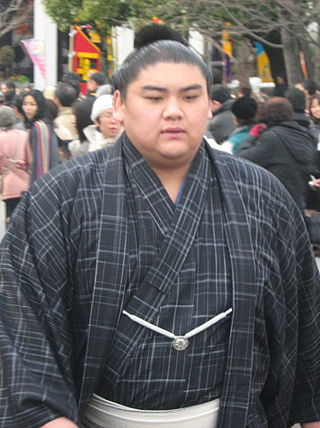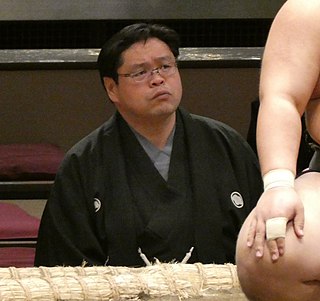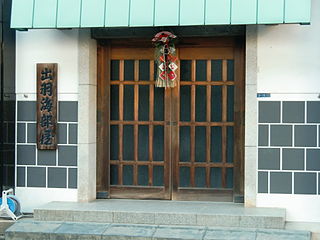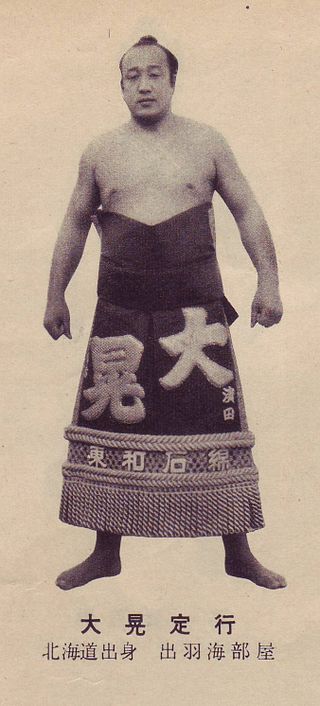Related Research Articles

Miyabiyama Tetsushi is a former sumo wrestler from Mito, Ibaraki, Japan. A former amateur champion, he turned professional in 1998. With the exception of two tournaments, he was ranked in the top division of professional sumo from 1999 until the end of his career in 2013, holding the second highest rank of ōzeki from 2000 to 2001. He won eight special prizes and was runner-up in four top division tournaments. He wrestled for Fujishima stable, where he worked as a coach until opening his own Futagoyama stable.

Futen'ō Izumi, is a former sumo wrestler. A former amateur champion, he turned professional in 2003, reaching the top division the following year. He earned two special prizes. His highest rank was komusubi, which he held for one tournament. He retired in May 2011 after falling down the banzuke to the third makushita division. He is now a sumo coach.

Tochinonada Taiichi is a former sumo wrestler from Ishikawa Prefecture, Japan. An amateur sumo champion, he turned professional in 1996 and reached the top makuuchi division in 1997. He earned twelve kinboshi or gold stars for defeating yokozuna, the second highest ever, and he was a runner-up in two tournaments. His highest rank was sekiwake. He is now a coach at Kasugano stable under the name Takenawa Oyakata.
Hayateumi Hidehito is a former sumo wrestler from Aomori, Japan. His highest rank was sekiwake. He is now a Liberal Democratic Party politician.

Dewanoumi stable is a stable of sumo wrestlers, part of the Dewanoumi ichimon or group of stables. It has a long, prestigious history. Its current head coach is former maegashira Oginohana. As of January 2023 it had 19 wrestlers.

Kasugano stable is a stable of sumo wrestlers, part of the Dewanoumi ichimon or group of stables. As of January 2023 it had 17 wrestlers. It has been led by former sekiwake Tochinowaka Kiyotaka since 2003. It was one of the most successful stables in 2013, with six sekitori wrestlers, including now retired Georgian Tochinoshin and Japanese born Tochinowaka Michihiro, who used the current head coach's old ring name.
Ryōgoku Kajinosuke IV is a former sumo wrestler from Nagasaki, Japan. His highest rank was komusubi. He is now a sumo coach under the name of Sakaigawa.
Oginishiki Yasutoshi is a former sumo wrestler from Ichikawa, Chiba Prefecture, Japan. His highest rank was komusubi. His father and brother were also sumo wrestlers. He is now a coach at Dewanoumi stable.
The following are the events in professional sumo during 2009.
The following are the events in professional sumo during 2006.
The following are the events in professional sumo during 2005.
The following are the events in professional sumo during 2000.
Ōzutsu Takeshi is a former sumo wrestler from Mie, Japan. Beginning his professional career in May 1971, he was ranked in the top makuuchi division continuously from March 1979 to January 1992, and his record of 1170 consecutive bouts there is the second best in history after Takamiyama. His highest rank was sekiwake. He was runner-up in one tournament and earned ten kinboshi or gold stars for defeating yokozuna. He also won four sanshō or special prizes. He wrestled for Taihō stable and after his retirement in May 1992 he worked there as a coach before leaving the Japan Sumo Association in 2008.
The following are the events in professional sumo during 1987.
Kitakachidoki Hayato is a former sumo wrestler from Obihiro, Hokkaidō, Japan. He made his professional debut in 1981, and reached the top division in 1989. His highest rank was maegashira 3. After retirement he became an elder in the Japan Sumo Association. He took over as head coach at Isenoumi stable, when former head coach Fujinokawa reached mandatory retirement age in September 2011.
Ōnishiki Ittetsu is a former sumo wrestler from Sado, Niigata, Japan. He made his professional debut in May 1968, and reached the top division in September 1973. His highest rank was komusubi. He retired in January 1988 and became an elder in the Japan Sumo Association under the name Yamashina, holding the Special Executive position.
Hagurohana Toji was a sumo wrestler from Nishiokoppe, Hokkaidō, Japan. He made his professional debut in September 1955, and reached the top division in September 1960. He was a prominent member of the top division during the Hakuho era, dominated by Taihō and Kashiwado. Upon retirement from active competition in 1965 at the early age of 29 he became an elder in the Japan Sumo Association under the name Onaruto and later Tamagaki. He left the Sumo Association in October 1972. He died of cancer in 1984 at the age of 48.

Ōhikari Sadayuki was a sumo wrestler and coach from Kamiiso, Hokkaido, Japan. He made his professional debut in January 1944, reaching the top makuuchi division in 1950. His highest rank was komusubi. He was a runner-up in the May 1956 tournament and earned five kinboshi or gold stars for defeating yokozuna during his career. He retired in 1963 and became an elder of the Japan Sumo Association under the name Ōnomatsu Oyakata, working as a coach at Dewanoumi stable. He died in 1996 at the age of 68.
The following are the events in professional sumo during 1992.

Kamikaze Shoichi was a sumo wrestler from Higashikagawa, Kagawa Prefecture, Japan. He made his professional debut in May 1937 and reached the top division in May 1942. His highest rank was sekiwake. He won six gold stars against grand champion yokozuna in the course of his career. Upon retirement from active competition he became an elder in the Japan Sumo Association under the name Kataonami. He left the Sumo Association in September 1952.
References
- ↑ "Oyakata (Coaches)". Nihon Sumo Kyokai. Archived from the original on 11 September 2012. Retrieved 3 September 2012.
- ↑ "Dewanohana Yoshitaka Rikishi Information". Sumo Reference. Retrieved 3 September 2012.